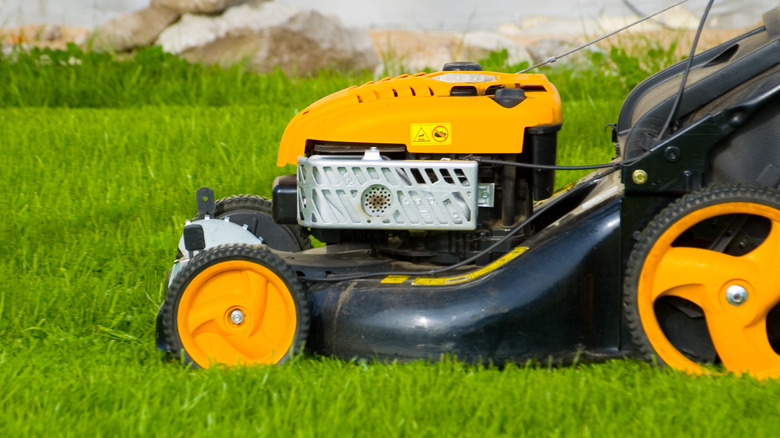When Is It Safe To Mow New Sod? Our Lawn Care Industry Expert Weighs In
If you've chosen to lay sod at your home or business to establish a beautiful lawn as quickly as possible, it's important to follow the proper installation steps to make the most of your investment, as the extra cost of the rolls is a significant difference in the sod vs. grass seed debate. After laying out the rolls, it's important to also take care of them properly, including determining when it's safe to start mowing. After all, you certainly don't want to make one of the most common mistakes and begin cutting the grass too early, as it could ruin your new grass and cause significant problems down the road with your yard.
"I tend to recommend waiting 15 days for new sod to establish before trying to mow," LawnStarter CEO Ryan Farley told House Digest in an exclusive interview. "Waiting 15 days gives the sod a chance to get established, put down roots, and so on. Mowing before then runs the risk of pulling up sod, meaning you'll have to start the process over again."
The instant results you receive from sod are a big advantage of using it within your lawn but don't be fooled by the look when trying to determine when it's time to begin mowing. The rolls look lush and green from the moment you lay them out, so you won't be able to tell exactly when the roots are established just from a quick glance.
How to test your sod to figure out if it's ready for mowing
If after the 15 days pass, you still aren't quite sure whether the sod is ready for mowing, you can perform a quick test to determine whether its roots are established properly. "I would just recommend choosing a spot near the edge of the sod and giving it a gentle tug first," Farley told House Digest. "If it lifts or has a lot of give, it's probably not ready for mowing yet. If it doesn't, you can give it a firmer tug to be sure. You're looking for sod that has clear resistance from established roots." He says you should pull on the grass blades in an out-of-the-way area of the new sod installation so you don't damage an area that's easily visible. Damage isn't likely, but you don't want to take any chances with your new rolls of sod.
If you're unsure what tugging on the grass should feel like when the roots are established — and so you don't tug on the new sod too hard — Farley suggests tugging on some established grass to gain a feel for the resistance it provides when the roots are strong and healthy. You don't want to yank the grass blades out of the rolls; you're just trying to see if the roll will pull away from the base soil into which the roots should be growing.
Key steps you should take before mowing sod
As another test before cutting, walk across the sod. If it feels like a wet sponge where you're sinking into the soil a little bit, you should not mow until it dries out and feels firmer. The spongy feel may be a sign that you're overwatering. If the ground feels even a little bit soft, you definitely should avoid using a riding mower. Because the rider is far heavier than a push machine, it may sink into soft ground.
Once you're sure the roots are established and the ground is firm enough to withstand the weight of the machine, then you should have no concerns about mowing. "If your new sod is properly established after 2 weeks, you should just mow it as normal," Farley told House Digest in an exclusive interview.
Most people will cut the sod at a length of about 2.5 inches after it's established. Make sure you are using recently sharpened blades on the mower, creating a clean tip on the new grass blades. Don't let the grass blades get too long, as you should never cut more than one-third of the total height of the grass.


